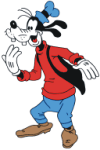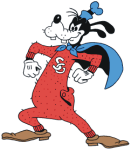Goofy

 Alias: Super Goof
Alias: Super GoofEyes: Black
Hair: Black and white fur
Race: Dog
Marital Status: Single
Identity: Secret
Known relatives: Max (son, only in "Goof Troop")
Gilbert (nephew)
Indiana Pipps (cousin, only in Italian comics)
Ophal Dizzy (uncle)
Effie (aunt)
Mighty Knight (ancestor)
Base of operations: DuckburgIndiana Pipps (cousin, only in Italian comics)
Ophal Dizzy (uncle)
Effie (aunt)
Mighty Knight (ancestor)
Story: Goofy is the good natured and slightly clumsy guy who solves crimes with his best friend Mickey Mouse and hangs out with his friends.
Goofy became Super Goof when he accidentally drank a cup of super fuel and thought he had gained super powers. He stripped down to his underwear (long johns) and put on a cape (an old potato sack) and went after the villain The Phantom Blot as Super Goof [2]. Shortly after Gyro gave him a cape which gave him some super powers so he could really be Super Goof [1].
The cape was only used briefly as Goofy discovered the super goobers in a goober patch in his back yard which gave him real super powers. The goobers had been irradiated by a nearby meteorite and changed into super goobers [3]. The story was later retconned into Goofy getting the super goobers from a Mexican superhero named Super Señor [5].
Having only a limited effect, it was difficult to maintain a secret identity as Super Goof as the effect of the goobers would suddenly wear off. The only one who discovered Super Goof's secret identity however was his nephew Gilbert. While searching for Goofy he found Super Goof just before the effect of the super goobers wore off and he changed into Goofy. Gilbert immediately joined Super Goof's adventures as the sidekick Super Gilbert [4].
Continuity: Disney
Publisher(s): Columbia Pictures
Disney
Dell Comics
Gold Key
Whitman Publishing
Gladstone
Gemstone
First app.: As Dippy Dawg: Mickey's Revue (May 12, 1932)Dell Comics
Gold Key
Whitman Publishing
Gladstone
Gemstone
As Goofy: The Whoopee Party (September 17, 1932)
As Super Goof: The Phantom Blot #2 (February, 1965)
Creator(s): Walt DisneyAs Super Goof: The Phantom Blot #2 (February, 1965)
Pinto Colvig
John Sutherland
Country of origin: USA John Sutherland

Background notes: When Goofy first appeared, he was a part of a crowd in the cartoon Mickey's Revue in 1932. He had no name at the time and sported a beard, but his looks and distinctive laugh, provided by voice actor Pinto Colvig, was there. In this cartoon and the following, he was given no name, but in the daily comic strip where he was introduced at the same time he was given the name Dippy Dawg, a name that had been used to identify him behind the scenes in the Disney Studio.
The name Goofy was not officially given until Goofy and Wilbur from 1939, but as early as The Whoopee Party from 1932 he is listed as Goofy instead of Dippy Dawg. Both names were used briefly but by Orphan's Benefit from 1934, the name Goofy stayed with the character. His character as we know it today really began to take shape in Moving Day from 1935, where animator Art Babbitt built up Goofy's role and gave his character definition.
In the beginning in both cartoons and comics, Goofy was a part of the supporting cast for the stars Mickey and Donald, but he soon became an equal partner in the stories and with Goofy and Wilbur, Goofy got his own cartoons.
In 1941, after Colvig had left Disney, a series of "How to"-cartoons started. In the cartoons, a narrator would instruct on subjects like riding a horse, skiing, self-defense etc. and Goofy carry out the instructions. Goofy being as clumsy as he is, the visuals became a hilarious demonstration of "How NOT to". Of these cartoons, How to Play Football from 1944, was nominated for an Oscar.
Up through the '50s, '60s, '70s, and '80s Goofy could be seen on several Disney television shows, like The Mickey Mouse Club, Disneyland, Walt Disney Presents, Walt Disney's Wonderful World of Color, and The Wonderful World of Disney in a mixture of new and old cartoons. Especially the formation of The Disney Channel in 1983 boosted the appearance of Goofy cartoons.
Following the idea of the "How to" cartoons, Goofy was in the '50s and '60s often cast in suburban settings as the "common man". Here he was equipped with the wonders of the modern world, including the occasional wife and kid, and demonstrated some of the pitfalls of modern living. He was given several names other than Goofy in these cartoons; George Geef was one of the recurring names. Rumor has it that both these and the "How to" cartoons are used for educational purposes e.g. Motor Mania from 1950 on how not to behave while driving a car.
In the vein of the suburbanites, the series Goof Troop started in September 1992 with Goofy as a single father with his teenage son Max. The series ran for 78 episode (last episode aired December 5, 1992) plus a special from December 5, 1993 and two feature films, A Goofy Movie released on April 7, 1995; and An Extremely Goofy Movie or Another Goofy Movie, released direct to video on February 28, 2000.
After Goof Troop, Goofy returned to his roots in Mickey Mouse House from 1999 and House of Mouse from 2001. Both series were an anthology series featuring a wide range of both new and old Disney character, including Goofy in more "How to" cartoons.
Goofy still shows up in cartoons. The latest being The Three Musketeers a direct to video movie released August 17, 2004, reuniting the team of Donald Duck, Mickey Mouse and Goofy.
In the comics, Goofy was mostly Mickey Mouse's sidekick for many years. Along with Chief O'Hara and Shamrock Bones they solved quite a lot of mysteries. Especially crimes committed by the Phantom Blot, Black Pete and Dangerous Dan McBoo and Idgit the Midget. Apart from a few solo issues in Four Color Comics from Dell, he had no series of his own as Goofy. He did however have other series.
With super-heroes gaining popularity in the early sixties, Disney had to have a super-hero too, and in 1965 Super Goof was created by Del Connell (story) and Paul Murry (art). Even though Super Goof is a super-hero spoof, the origin isn't actually that different from "real" super-heroes like Spider-Man, Metamorpho and Doctor Solar who also got their powers from freak accidents involving radiation, or Hourman's Miraclo which would give him super-powers for one hour. It's only the long underwear actually being long underwear and Goofy's personality, which makes it a spoof. Super Goof had his own series from Gold Key (1965, Issue 1-57) and Whitman (1980, Issue 58-75). In cartoons, Super Goof did not appear until Feb. 2, 2002 in an episode of the Saturday morning show, House of Mouse. Goofy's voice was done by Bill Farmer.
In Europe, Goofy got his own series, but not in the usual sense. The stories were in the graphic novel format favored in Europe with Goofy as either a historical person (e.g. Gutenberg and Columbus) or as literary character (e.g. Phileas Fogg). The stories were spoofs with the crazy logic only Goofy can muster, e.g. as Columbus he attached a piece of garden on the ceiling and attempted to walk upside down, and as Gustav Eiffel he made the Eiffel Tower with hinges at the bottom so the tower could be build on the ground and then raised. As always, his best friend Mickey Mouse was present, either as his friend or his helper or both.
Goofy has of course also been transferred to other medias. Merchandizing started as early as 1935, and there is practically no limit to where Goofy can appear. The most obvious being toys for kids, but also watches, pins, labels, mouse pads and thousands of other items.
One of the more unusual transfers was when Goofy was named the official mascot of the French Olympic team in 1980. He was endorsed by the German Sport Association, and also became the mascot of the International Tennis Federation Junior World Tennis Championship. Being a mascot naturally resulted in a wide range of sporting accessories with Sport Goofy. He even got his own anthem of confidence to young people, a song entitled You Can Always Be Number One.
Goofy also crossed over to computer games. Games are available for PC (Extremely Goofy Skateboarding) and Playstation (Goofy's Fun House).
Related links/characters:
- Disney Characters
- Black Pete
- Chief O'Hara
- Clara Cluck
- Clarabelle Cow
- Dangerous Dan McBoo
- Detective Casey
- Gilbert/Super Gilbert
- Gyro Gearloose
- Horace Horsecollar
- Idgit the Midget
- Indiana Pipps
- Ludwig Von Drake
- Max
- Mickey Mouse
- Minnie Mouse
- Morty and Ferdie
- Phantom Blot
- Pluto
- Shamrock Bones
- Black Pete
- Chief O'Hara
- Clara Cluck
- Clarabelle Cow
- Dangerous Dan McBoo
- Detective Casey
- Gilbert/Super Gilbert
- Gyro Gearloose
- Horace Horsecollar
- Idgit the Midget
- Indiana Pipps
- Ludwig Von Drake
- Max
- Mickey Mouse
- Minnie Mouse
- Morty and Ferdie
- Phantom Blot
- Pluto
- Shamrock Bones
Cross cultural references:
If you enjoyed this character/series, you might enjoy
References: 1: Donald Duck #102
2: Phantom Blot, The #2
3: Super Goof #1
4: Super Goof #5
5: Super Goof #31
3: Super Goof #1
4: Super Goof #5
5: Super Goof #31